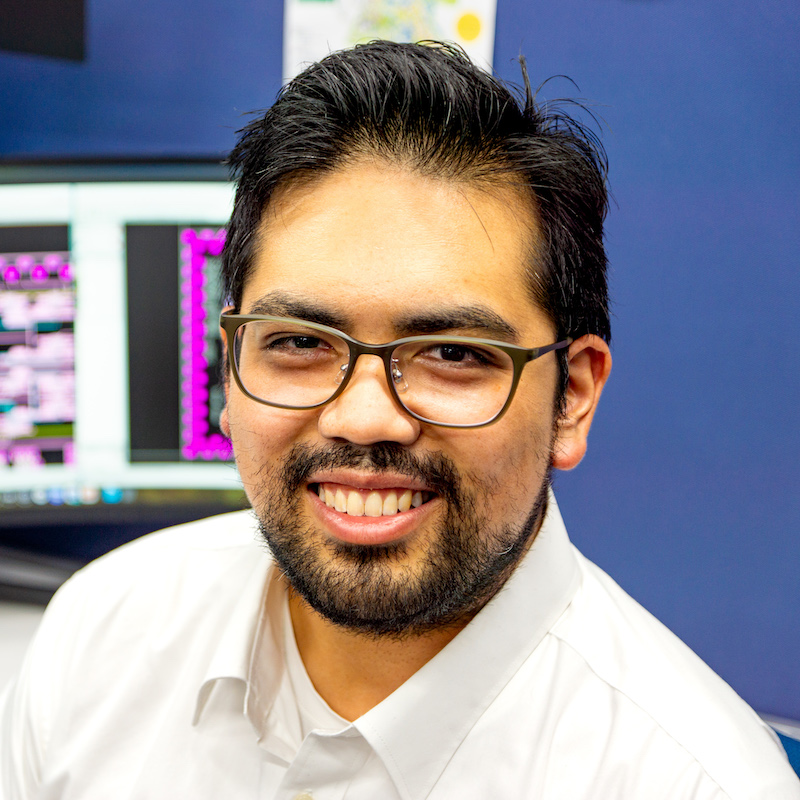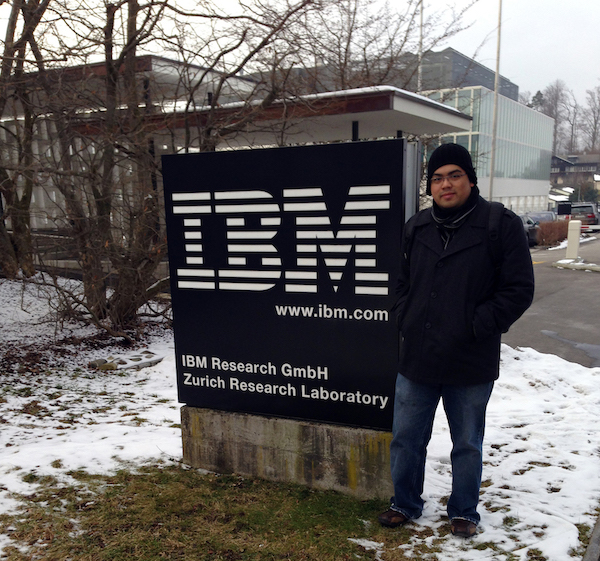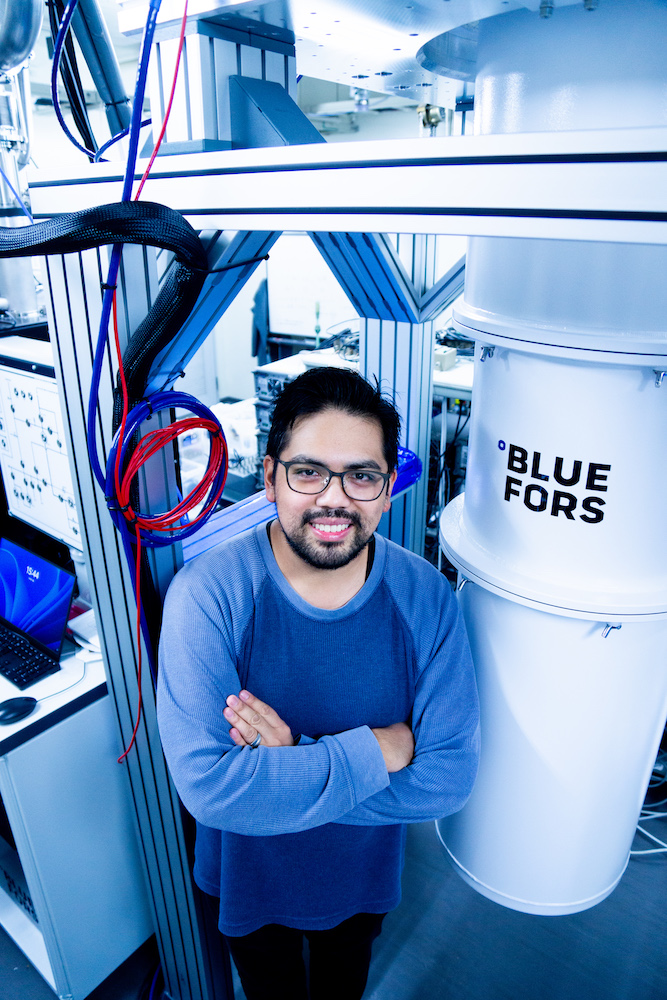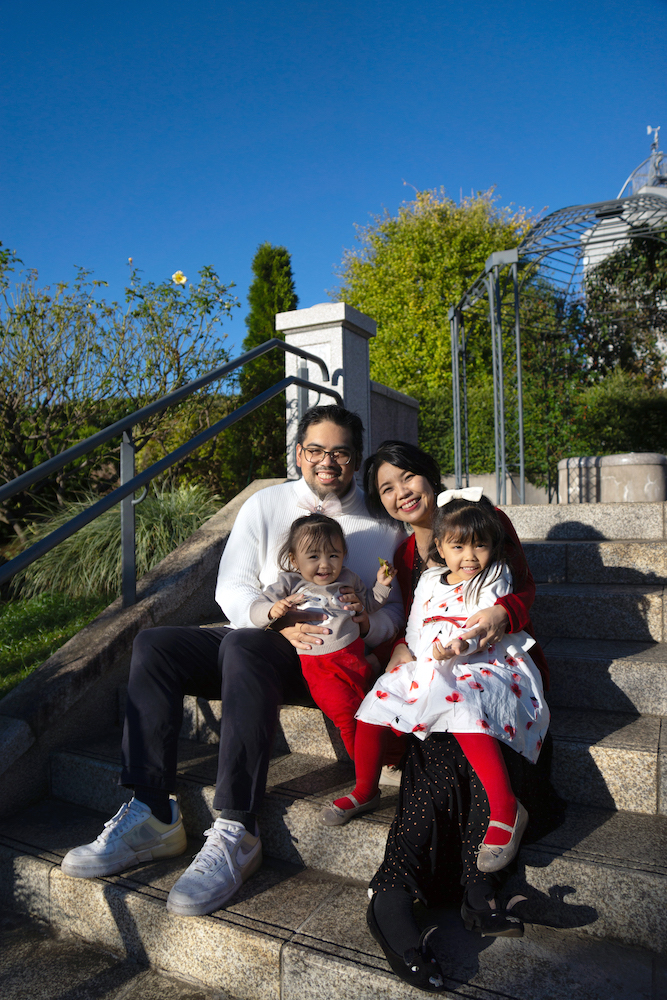Christopher Ayala (PhD CE 2012, MS/BE EE/CE 2009)
The Beginnings
 Prof. Chris Ayala, who graduated in 2012 from Stony Brook University’s Dept. of Electrical
and Computer Engineering with a PhD in computer engineering, has worked on three continents.
How did he get started on this path? In the mid-1990’s his father bought his family
their first “productive” personal computer, a Packard Bell with a 75 MHz Intel Pentium,
8 MB DRAM, 722 MB hard drive storage running a variety of Windows from 3.1 to Windows
98. Chris then started getting into 3D animation and modeling and worked on computer-generated
imagery (CGI) short films for high school projects. By the time he matriculated at
Stony Brook University, one of his goals (although it felt quite farfetched at the
time) was to somehow work at NVIDIA due to his interests in 3D CGI and games. He eventually
did it as a graduate student intern for the ASIC streaming multiprocessor team at
NVIDIA.
Prof. Chris Ayala, who graduated in 2012 from Stony Brook University’s Dept. of Electrical
and Computer Engineering with a PhD in computer engineering, has worked on three continents.
How did he get started on this path? In the mid-1990’s his father bought his family
their first “productive” personal computer, a Packard Bell with a 75 MHz Intel Pentium,
8 MB DRAM, 722 MB hard drive storage running a variety of Windows from 3.1 to Windows
98. Chris then started getting into 3D animation and modeling and worked on computer-generated
imagery (CGI) short films for high school projects. By the time he matriculated at
Stony Brook University, one of his goals (although it felt quite farfetched at the
time) was to somehow work at NVIDIA due to his interests in 3D CGI and games. He eventually
did it as a graduate student intern for the ASIC streaming multiprocessor team at
NVIDIA.
Prof. Ayala didn’t have any particular role model with regard to engineering. Both of his parents were registered nurses but they encouraged his brother and him to pursue STEM fields. Prof. Ayala says that he was primarily driven to work for a Silicon Valley company like NVIDIA, Intel, AMD, and the like.
During his undergraduate days, Travis Choberka, Jun Lin, Frederick Rubino, and Chris were a bit of a computer engineering hive mind, studying together and working on some of the challenging projects that were assigned to them until late at night. They were all commuter students, so they had a bit of a comradery among them. He still talks to them a bit these days and most recently caught up with Travis as he proposed to his girlfriend at the top of the Tokyo Tower earlier this year (2023). Alba Escobar of electrical engineering was also a great EE lab mate and study partner.
In graduate school, Ikechukwu “Aike” Okoligwe (see alumni profile on this website) and Glenn Roach were great classmates as well and they worked together on various class projects. Prof. Ayala cherishes the memories of his lab mates in Prof. Dorojevets’ laboratory, especially fellow PhD graduate Dr. Artur Kasperek. He was with him from the very beginning of graduate school until they both finished their doctorate degrees. Artur was juggling a full-time job at Motorola, evening graduate classes, and raising a young family on top of his research – Prof. Ayala still doesn’t know how Artur managed to do all that and he finds all of that even more impressive now that he has a family of his own.
The research of Prof. Ayala intersects several specializations including devices, circuits, logic design, VLSI, reliability theory, computer architecture, and electronic design automation. He can proudly say that the professors in the ECE department prepared him well. In particular he would mention his PhD advisor Prof. Dorojevets (computer architecture, superconductor circuits), Prof. Doboli (intro to VLSI, PSoCs, EDA algorithms), Prof. Hong (VLSI, DSPs), Prof. Robertazzi (reliability theory, performance evaluation), Prof. Salman (advanced VLSI, beyond-CMOS), and Prof. Short (VHDL/Verilog, FPGAs) all contributed to the foundation of knowledge he uses today. Circling back to his dream of working in Silicon Valley, the combination of Prof. Dorojevets’ graduate computer architecture course and Prof. Salman’s nanoscale IC design course gave him tremendous confidence going into the technical interviews after which he had the luxury of choosing from multiple summer intern offers including his childhood favorite, NVIDIA.
An IBM Post Doc
Towards the end of his PhD education, Prof. Ayala was coming to grips with whether he wanted to do development in industry as an engineer or continue his research for a big defense contractor or national laboratory. Unexpectedly, a third option came up: do research in industry on a completely new topic. That was his postdoc at IBM Research Zurich. He wanted to broaden his expertise. He worked on nanoelectromechanical switches (NEMS) for energy-efficient computing, particularly for edge devices. It was his first time living on his own (except for a few months as an intern). It was even the first time for him to travel to Europe. It was also the first time he saw “Dr.” on his nameplate, something that he’s still not used to seeing to this day. Adjusting to expat life was initially quite difficult. Different cultures, languages, day-to-day logistics, and of course a completely different research topic.

Prof. Ayala didn’t learn about NEMS/MEMS at Stony Brook, but they’re fascinating devices that combine both electrical and mechanical properties as the name implies. A big challenge was improving and measuring the reliability of the switches. Prof. Robertazzi’s course on reliability theory helped him craft the experimental setup and the means to characterize the reliability of the prototype switch. He eventually became one of the work package leaders for the European Union-funded project, demonstrating record-breaking switching speeds and endurance, resulting in a “Best Young Scientist” paper award at the European Solid-state Device Research Conference (ESSDERC). He had a very supportive manager who helped him see the project through to the end and he looks back quite positively on his postdoc experience. As his appointment was concluding, Prof. Ayala felt he was adjusting very well to life in Switzerland. The experience enabled him to now consider the world as his “laboratory,” and not just limit himself to a single country.
Working in Academia in Japan
As a graduate student under Prof. Dorojevets, the group collaborated with Prof. Nobuyuki Yoshikawa (Yokohama National University, Japan), a renowned professor in superconductor electronics. This gave Prof. Ayala multiple opportunities to travel to Japan for workshops and to do cryogenic experimental work in Prof. Yoshikawa’s lab. He already had an interest in Japan thanks to anime and gaming, so every visit to Japan was an exciting experience for him. Prof. Ayala especially had a wonderful time interacting with Prof. Yoshikawa’s students. A few of them would eventually become his collaborative colleagues today including Prof. Naoki Takeuchi and Prof. Olivia Chen. He told himself, that if there was a chance to live/work in Japan, he would seriously consider it. That chance came as his IBM postdoc appointment was coming to an end. Prof. Yoshikawa reached out to him coincidentally as Yokohama National University was establishing a new institute of advanced sciences and was recruiting international researchers to join. It was a “no-brainer” for him to accept Prof. Yoshikawa’s offer and he has been here at Yokohama National University (YNU) ever since.
Exciting Research
 Today Prof. Ayala is a member of Yokohama National University’s Institute of Advance
Sciences (IAS) in the Quantum Information Research Center (QiC). He primarily does
research on a superconductor logic family based on adiabatic quantum-flux-parametrons
(AQFPs). The AQFP is a basic building block for creating adiabatic superconductor
logic gates, similar to how pairs of PMOS and NMOS transistors are used to build CMOS
logic gates. As the name implies, AQFPs operate adiabatically meaning that in theory,
the energy it uses to perform a logic computation can be completely recovered. In
practice, one cannot completely recover the energy because there are always sources
for non-adiabatic dissipation, but one can still recover a substantial amount back.
As a result, the AQFP can dissipate as little as 1 zJ per clock cycle at multi-GHz
speeds. Now, these circuits are superconducting, so we need to expend power to cool
them below their critical temperature so that they enter the superconducting state
(typically below 9K for niobium-based AQFPs).
Today Prof. Ayala is a member of Yokohama National University’s Institute of Advance
Sciences (IAS) in the Quantum Information Research Center (QiC). He primarily does
research on a superconductor logic family based on adiabatic quantum-flux-parametrons
(AQFPs). The AQFP is a basic building block for creating adiabatic superconductor
logic gates, similar to how pairs of PMOS and NMOS transistors are used to build CMOS
logic gates. As the name implies, AQFPs operate adiabatically meaning that in theory,
the energy it uses to perform a logic computation can be completely recovered. In
practice, one cannot completely recover the energy because there are always sources
for non-adiabatic dissipation, but one can still recover a substantial amount back.
As a result, the AQFP can dissipate as little as 1 zJ per clock cycle at multi-GHz
speeds. Now, these circuits are superconducting, so we need to expend power to cool
them below their critical temperature so that they enter the superconducting state
(typically below 9K for niobium-based AQFPs).
But even with a conservative cryostat cooling efficiency of 1000 W for every watt dissipated at cryogenic temps, the bit energy of the AQFP is still a fantastic 1 aJ per cycle. Combining that with a respectable clock frequency of 5 GHz to 10 GHz, one can perform adiabatic computing with practical performance suitable for data centers and supercomputers that power society’s digital information and communications infrastructure. Towards that end, Prof. Ayala and collaborators designed and successfully demonstrated the world’s first adiabatic superconductor microprocessor published in the IEEE Journal of Solid-State Circuits and it was picked up by media outlets such as IEEE Spectrum, Superconductor Week magazine, Nikkei xTECH, and more. The work revealed new challenges and research directions to tackle. This includes new microwave clocking schemes, improved integration densities and signal integrity, memory cells, and logically-physically reversible computation. All of which Prof. Ayala and his collaborators are pursuing now.
Other Exciting Research
In addition to adiabatic microprocessors for general-purpose computing, Prof. Ayala recently finished presenting for a 1 AM (Japan time) DARPA (US Defense Advanced Research Projects Agency) review meeting for a project on fully homomorphic encryption (FHE) using superconductor electronics in collaboration with the University of Southern California and Stellenbosch University (South Africa). FHE is a very exciting topic in which general computation can be done directly on encrypted data without having to decrypt them beforehand. The process is computationally intensive, but it can be substantially accelerated using energy-efficient superconductor electronics. His group was responsible for developing the superconducting memory sub-system for the processing elements of an FHE accelerator. This may open new ways to do superconducting compute-as-a-service on sensitive data while still preserving security and privacy.
Prof. Ayala is also very interested in quantum computing as well, trying to apply AQFP technology to perform the classical computation needed to control superconducting qubits and perform error correction while reducing the I/O between the cooling stages and room temperature electronics. He also started to revisit the NEMS devices from his postdoc experience with the advent of improved nanolithography techniques and novel materials that are now available for fabrication.
What is it Like Living in Japan?
Prof. Ayala thinks a lot of people experience culture shock when visiting Japan for the first time. He got that out of the way when he first visited Prof. Yoshikawa’s laboratory as a PhD student. He would say the real culture shock for him happened when he moved to Switzerland and worked at IBM Research Zurich. By the time he decided to move to Japan, he was already a hardened expat. The language barrier is a big hurdle that’s quite common for many who move to Japan. After 8 years, he would say he is still far from fluent but proficient enough for day-to-day matters and small talk. He supposes this is also compounded by the fact that his colleagues and he use English in the university, but it also encourages students to practice their English. He also teaches graduate courses which are required to be taught in English.
Today Prof. Ayala says Japan is a dichotomy of high and low tech. The public transportation infrastructure is world-class. He hasn’t had a real need for a car although this is changing as his family is getting bigger. You’ll see robots serving at some restaurants and mowing lawns. He has been spoiled by next-day or even same-day delivery available all days of the week. But it is still a paper-driven society. Even while working remotely during COVID, he still had to come to campus once in a while to put his “hanko” (signature stamp) on various administrative documents. A lot of banks have been quite slow to embrace online banking and when they did, there were issues. Faxing is still a thing. Once he got over the “honeymoon” period of seeing the beautiful sights and enjoying the delicious food and drinks, the rose-colored glasses came off and he now has a more complete picture of Japan – but he should say, this is basically how expat life is all over the world.
Prof. Ayala likes living in Japan, he even has permanent residency. It’s challenging, stimulating, and he is learning a lot. He met his wife in Tokyo, and they’ve been married for 5 years. They had the wedding at her grandfather’s home in the countryside of Niigata. The wedding somehow got so much local attention that it was featured in a popular Japanese wedding magazine, Zexy. Prof. Ayala and his wife have two daughters with one more on the way, and they are constantly thinking about their future. In any case, they are doing their best to make the most of their lives in Japan, but he is keeping an ear open for the right opportunities in Japan or elsewhere moving forward.

How are Japanese universities similar/different from US universities, particularly for students?
Unlike in the US, the “national” universities (public universities) are generally more prestigious than private universities in Japan. Quite recently, the Japanese government is planning to completely cover university tuition and related expenses for families with three or more children. It is very possible to get a quality cost-effective university-level education.
A major difference is that each Japanese academic laboratory gets a certain number of incoming fourth-year undergraduate students every year. They’re required to join a laboratory and they get to decide which are the top 3 or so labs they’d like to join. The lab that they will join depends on the number of slots available at their desired lab and their academic record (strong students get higher priority). In engineering, only a few will leave after completing their bachelor’s degree and start working. Most will continue to stay in the same lab for two more years to obtain a master’s degree. Most students do not continue into the PhD program, but this also depends on the availability of laboratory funds. This steady influx of fresh students every year for each lab establishes a hierarchy where laboratory knowledge and know-how are systematically passed down from the senior students to the incoming students.
Prof. Ayala has also noticed much less emphasis on practical training (e.g., hands-on coding, tutorials, design projects) in the lectures/classroom and a stronger emphasis on theoretical concepts. Most of the practical training is provided by the laboratory that the student joined. The quality of this training varies as it is closely tied to the research themes of the laboratory and of course the research topic of the student. That is why he’s paid special attention to the practical skill development of the students he supervised, especially if they have a desire to join an international company.
Advice for Stony Brook Students
It sounds like a cliché but Prof. Ayala says you won’t get the most out of your education if you’re just passively going through the lectures and labs. He says “Be proactive. Ask questions, go to office hours, and talk to the TA. Don’t just do the labs quickly so you can get out early. Work through the material and experiment a bit more beyond what the lab assignment calls for to further your understanding. Find people you connect well with, maybe at the IEEE student chapter. Study and work on projects together. Learning how to deal with other engineers is very important as the amazingly complex marvels we’re building now are not done by a lone-wolf “hero” engineer but by a well-coordinated team. I can’t emphasize projects enough. Take pride in them. Know every little detail about what you’ve done, how you approached the solution, and what improvements can be made. These are all great things to talk about at job interviews.”
